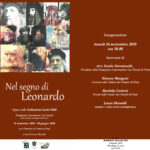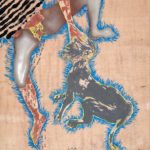Piero Manai – P420 e CAR DRDE – Bologna
Piero Manai
CAR DRDE
Bologna
Inaugurazione venerdì 27 settembre 2019 dalle ore 18:00
P420, Via Azzo Gardino 9, Bologna
CAR DRDE, Via Azzo Gardino 14/a, Bologna
Le gallerie P420 e CAR DRDE sono liete di annunciare la mostra personale di Piero Manai, uno degli artisti più straordinari ed enigmatici degli ultimi decenni, prematuramente scomparso nel 1988 all’età di 37 anni.
Umberto Eco, nel 1991, scriveva che “Manai, dopo Giorgio Morandi, stava continuando il discorso della grande pittura bolognese”.
La mostra, organizzata in collaborazione con gli eredi dell’artista, è dislocata negli spazi di P420 (Via Azzo Gardino 9) e CAR DRDE (Via Azzo Gardino 14/a) e comprende una selezione di opere realizzate da Manai negli anni ’80.
Piero Manai si mette subito in luce nei primissimi anni ’70 negli ambienti bolognesi grazie a una pittura che, per usare le parole di Flavio Caroli (che lo inserirà nel suo libro “Trentasette, il mistero del genio adolescente”) e Pietro Bonfiglioli “fonde iperrealismo e astrazione concettuale”, “dipingendo sempre in qualche modo l’idea stessa del dipingere”.
Nei primi anni ’70 si ammala poco più che ventenne e impiegherà diversi anni a guarire. Questa tragica esperienza determina, nei primi anni ’80, un cambiamento nel suo modo di dipingere, che diventa convulso e drammatico, e nei suoi soggetti.
Aveva infatti un bisogno quasi ossessivo di disegnare o dipingere figure e teste che, quasi sempre private di gran parte dei loro tratti fisiognomici, sembrano avere una fisicità chiusa in sè, cieche e sorde (come sottolineano alcuni suoi titoli, Figura sorda o Pittore cieco) assorte e isolate dentro il proprio peso e perse in uno spazio bianco privo di coordinate.
Prive di un’espressione o di una psicologia, quasi in disfacimento, non sono rappresentazioni né ritratti. Sono forse più precisamente autoritratti, e non sono visti da fuori, ma da dentro. “E’ un lavoro interno” – scrive lo stesso Manai – “E’ una costruzione anatomica e psichica, è dipingere una figura, scorticarla tre volte, metterla a dura prova per raggiungere una soglia”.
Le teste di Manai spesso portano pesi, pietre, figure che gravano il corpo sotto il loro peso. “Sono uomini con i pesi in testa” li aveva definiti l’artista stesso. Le teste e i corpi spesso degenerano in volumi la cui forma ricorda quella di un sasso, di una grande pietra, di un monolite.
Ammalatosi nuovamente, Manai muore nel 1988. “Era come se avesse un peso invisibile in testa”, ricorda Pietro Bonfiglioli che lo aveva incontrato poco prima.
Alla P420 è in mostra una selezione tra le più significative Figure, Teste e Monoliti dipinti su tela, carta intelata e acetato, tecnica quest’ultima tanto amata da Manai. Alla CAR DRDE è invece in mostra una selezione tra le più significative Nature morte, opere particolarmente importanti nel percorso dell’artista, che hanno già in sè quell’inquietudine, senso di precarietà e, forse, quell’anatomia, così caratterizzanti del lavoro di Manai.
Il suo linguaggio pittorico sembra non riducibile a nessuna delle diverse pratiche artistiche in vigore all’epoca, dall’espressionismo austro-tedesco degli anni ’80, alla più italiana Transavanguardia per citarne alcune. Anzi, nella sua diversità, sembra riunirle tutte, a tal punto che è difficile trovare un modo, forse inutile, di classificarlo.
Manai ha esposto in diverse gallerie e musei in Italia e all’estero tra cui PS1 di New York (1982).
Ha partecipato alle mostre Nuova Immagine presso la Triennale di Milano (1980), Linee della ricerca artistica italiana 1960-80 al Palazzo delle Esposizioni a Roma (1981), Italian Art 1960-80 alla Hayward Gallery di Londra (1982), alla Biennale des jeunes di Parigi (1982) ed esposto al Kunstverein di Hannover (1985) e di Francoforte (1986). La GAM di Bologna gli ha dedicato una vasta retrospettiva nel 2004 a cura di Peter Weiermair.
La mostra è accompagnata da un testo di Alberto Salvadori.
///
Piero Manai
opening Friday 27 September 2019
18.00-20.30
until 9 November 2019
press conference Thursday 26 September 2019, 11.00 at P420, followed by a visit to both exhibitions
P420, Via Azzo Gardino 9, Bologna
CAR DRDE, Via Azzo Gardino 14/a, Bologna
The galleries P420 and CAR DRDE are pleased to announce a solo show by Piero Manai, one of the most extraordinary and enigmatic artists of recent decades, who died prematurely in 1988, at the age of 37.
In 1991 Umberto Eco wrote that “Manai, after Giorgio Morandi, was continuing the discourse of great painting in Bologna.”
The exhibition organized in collaboration with the artist’s heirs is held in the spaces of P420 (Via Azzo Gardino 9) and CAR DRDE (Via Azzo Gardino 14/a), and includes a selection of works made by Manai in the 1980s.
Manai gained immediate notice in the early 1970s in Bolognese circles thanks to a kind of painting, to use the words of Flavio Caroli (who inserted the artist in his book Trentasette, il mistero del genio adolescente) and Pietro Bonfiglioli “blends hyperrealism and conceptual abstraction,” “always somehow depicting the idea of painting itself.”
In that period Manai, just into his twenties, fell ill, and it took a number of years for him to recover. This tragic experience brought about a drastic change in his way of painting and in his subjects, in the early 1980s, which became more convulsive and dramatic.
He had an almost obsessive need to draw or paint heads, nearly always deprived of most of their physiognomic features. The heads have a self-contained physical quality, blind and deaf (as underscored by some of the titles, Deaf Figure or Blind Painter), pensive and isolated inside their own weight, lost in a white space lacking in coordinates.
Lacking expression or psychology, almost coming apart, they are neither representations nor portraits. They are perhaps more precisely self-portraits, and they are not seen from outside, but from inside.
“It is an inner work – Manai wrote – an anatomical and psychic construction. To paint a figure, to skin it three times, to put it to the test in order to reach a threshold.”
Lacking expression or psychology, almost falling apart, the works are neither representations nor portraits. They are perhaps more precisely self-portraits, and they are not seen from outside, but from inside.
“It is an inner work” – Manai wrote – an anatomical and psychic construction. To paint a figure, to skin it three times, to put it to the test in order to reach a threshold.”
Manai’s heads often bear weights, stones, figures that burden the body under their heft. “They are men with weights on their heads,” as he defined them. The heads and bodies often degenerate into volumes whose form is like that of a rock, a large stone, a monolith.
After again falling ill, Manai died in 1988. “It was as if he had an invisible weight in his head,” Pietro Bonfiglioli recalls, after meeting him slightly earlier.
At P420 the show presents a selection of the most significant Figures, Heads and Monoliths painted on canvas, mounted paper and acetate, a preferred technique for Manai. At CAR DRDE visitors can see some of the most outstanding Still Lifes, works that are particular important for the artist’s path and already contain that disquiet, that sense of the precarious and perhaps the anatomy that so vividly set the tone of Manai’s output.
His pictorial language does not seem related to any of the various artistic practices current at the time, from Austrian-German Expressionism of the 1980s to the more Italian Transavanguardia, just to indicate two of them. In fact, in its diversity it seems to reunite them all, so much so that it is hard to find a (probably useless) way of classifying the work.
Manai showed in various galleries in Italy, and abroad at PS1 in New York (1982). He took part in the exhibitions Nuova Immagine at the Milan Triennale (1980), Linee della ricerca artistica italiana 1960-80 at Palazzo delle Esposizioni in Rome (1981), Italian Art 1960-80 at the Hayward Gallery in London (1982), the Biennale des Jeunes in Paris (1982), and showed work at the Kunstverein in Hannover (1985) and Frankfurt (1986). The GAM in Bologna held a large retrospective in 2004, curated by Peter Weiermair.
The exhibition is accompanied by an essay by Alberto Salvadori.




